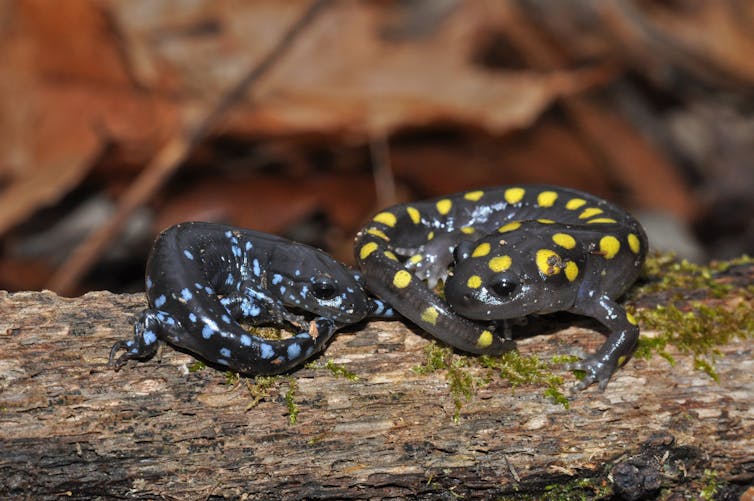Female Animals That Are Continuously Sexually Receptive
Not all species need sperm to fertilize an egg for sexual reproduction. Some species need sperm in order to induce completion of egg nucleus development, but then never use the sperm's DNA. I describe how this self-sexual reproduction occurs in many animals, including some insects, molluscs, fish, amphibians and reptiles, but not mammals.
People have long understood that ejaculate is needed for human pregnancy, but did not understand much more. In the late 1600s, the Dutch scientist Antonie van Leeuwenhoek, who was one of the first microbiologists, thought his own sperm were parasites.
For most of the 1700s and 1800s, people thought that sperm contributed nothing more than a spark to start development of an egg, although eventually decided — in a sexist fashion — that sperm contributed all the information and developmental instructions, while eggs merely provided a nutrient-rich vessel for the developing fertilized egg — zygote — and fetus.
In 1890, after chromosomes were seen under improved microscopes, German biologist Oscar Hertwig realized that egg and sperm each contributed half the normal number of chromosomes to a zygote.
Therefore sexual reproduction has two parts: halving the normal number of chromosomes per cell nucleus, which is called meiosis, and restoring the normal number of chromosomes per nucleus, usually by combining chromosomes from an egg nucleus and a sperm nucleus, which is called fertilization.
But, as we will see, in many species, only meiosis is needed.
Some form of sex
It seems that all animals eventually need to engage in some form of sex. Human cells contain a nucleus with 46 chromosomes. When it goes through meiosis, the cells — and all its intracellular components, including the nucleus — multiply and then split, so that one cell with one nucleus and 46 chromosomes becomes four cells with four nuclei and 23 chromosomes.
Meiosis in all animals proceeds the same way. It starts with a duplication of all chromosomes in a cell nucleus that has the normal number of chromosomes (46 in humans) — all nuclear divisions start with a chromosomal duplication. Cryptic sex is how biologists refer to undetected meiosis.
Not only do our bodies degrade as we age, but so do our chromosomes, which tatter at the edges. As far as we know, the only things that rejuvenate chromosomes and cell lineages is sex vis-à-vis meiosis or fertilization.
Next, this nucleus with twice the normal number of chromosomes divides those equally between two nuclei, and then divides each of these equally again, to form four nuclei, each with half the normal number of chromosomes. Thus, either four egg or four sperm nuclei are formed. Egg cells contain four egg nuclei plus as many sperm nuclei as manage to get inside the egg cell. This is where things get interesting.
No sperm required
We often only consider one egg nucleus fusing with one sperm nucleus to form a zygote nucleus and the other nuclei are discarded. But two egg nuclei can fuse to form the zygote nucleus, with all other egg and sperm nuclei ejected or discarded, a process called gynogenesis.
Meiosis of animal eggs usually requires a sperm cell to finish egg meiosis, but with gynogenesis, no sperm chromosomes are used in the zygote and both egg nuclei were from the same meiosis. Gynogenesis occurs in many different animals, including lots of fish, amphibians and reptiles, but not in mammals.
Gynogenesis can occur in other ways. With four egg nuclei per egg cell, each with half the normal number of chromosomes, and this time with no sperm, two of the four egg nuclei can fuse with one another to form a zygote. The remaining two nuclei are ejected or degraded. Alternatively, one of the four egg nuclei could spontaneously duplicate all of its chromosomes to form a viable zygote without fertilization, as occurs in some fish and salamanders.

As another alternative, a spontaneous doubling of all chromosomes can occur just before meiosis, in which case the four egg nuclei at the end of meiosis will have the normal number of chromosomes and therefore one of them can form a zygote without fertilization. I would consider any of these gynogenetic scenarios to be cryptically self-sexual because they involve meiosis, but this is often called asexual reproduction.
With four egg nuclei and any number of sperm nuclei per mature egg cell, each with half the normal number of chromosomes, there are other ways to get self-sexual reproduction. Two sperm nuclei can fuse to form a normal zygote or one sperm nucleus can spontaneously duplicate all its chromosomes to form a normal zygote, with processes called androgenesis.
With androgenesis, all four egg nuclei are ejected or degraded, with the egg just providing a large nutritious cell to support the sperm nuclei. That resembles conceptualizations of sex from the 1800s! Compared with gynogenesis, androgenesis is extremely rare, only known from a few insects and molluscs.
The bottom line is that, except for mammals, asexual reproduction is quite common, but is often really self-sexual reproduction.
maitlandwitena1952.blogspot.com
Source: https://theconversation.com/cryptic-sex-how-female-and-unisexual-animals-reproduce-asexually-without-males-154998